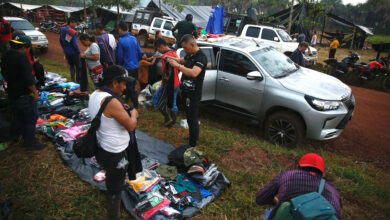Colombia’s Chocó, abandoned and engulfed by violence

By Ricardo Maldonado Rozo
Bojayá, Colombia, May 8 (EFE).- The anxiety is palpable from the moment the boat leaves Quibdó and sets off along the Atrato river that skirts the capital of Colombia’s Chocó region.
Here, paramilitary groups control the waterway and travel along the river is impossible without their permission.
Their presence can be felt just 15 minutes outside of Quibdó, where riverfront buildings are daubed with their initials ‘AGC,’ which stands for the Autodefensas Gaitanistas de Colombia (the Gaitanist Self-Defense Forces of Colombia), a group also known as the Gulf Clan.
People around these parts whisper about the paramilitary groups, fearing their presence in the villages.
“The Chocó Department is at a crossroads and is experiencing a very serious humanitarian crisis,” Leiner Palacios, a member of Colombia’s Truth Commission and a survivor of the Bojayá massacre committed by the Revolutionary Armed Forces of Colombia (FARC) in 2002, tells Efe.
Speaking from Bojayá following a ceremony to commemorate the 20th anniversary of the May 2 massacre, in which around 100 people were slain, including 48 minors, Palacios says the security situation in the region has “deteriorated.”
Palacios also accuses members of Colombia’s armed forces of colluding with the armed groups, including the AGC.
“This collusion is evident because they (the military) do not carry out operations to restrict the actions of these illegal armed groups,” he adds.
“Narcotrafficking is still going on in these territories,” Palacios says.
“In Bojayá, four years ago, there wasn’t even one coca plantation,” he adds. “Now there are several hectares.”
The commissioner, who traveled to Bojayá to pay tribute to victims of the massacre, which claimed 32 of his relatives, says locals are alarmed at the growing violence in the region.
“They told me of young boys and girls who have fallen into drug addiction and alcoholism and how this phenomenon is growing here.”
The conflict, he says, is linked to state neglect of the region and a surge in poverty.
Around 70% of the population in the region are being affected by restrictions enforced by the paramilitary groups, which prevent people from accessing their farmland and fishing grounds on the river, he says.
“There are no businesses here, no incomes. People live from farming and fishing, and when those activities are suspended (…) this leads to more poverty.”
The majority of Chocó’s Afro-Colombian population make their living from farming and fishing. Many live in stilt houses and hamlets scattered through the jungle without official public services or adequate roads. The river is, therefore, a vital network.
“We have always been abandoned by the state,” Faustino Flores Palacios, who was 12 when the massacre took place, tells Efe.
In the region today, locals live in fear of clashes between the AGC and guerillas from the National Liberation Army (ELN), who also claim the territory.
The use of rape and sexual assault as a weapon of war continues to be reported in the region, which is blighted by the high rate of teen suicide, which in some cases is attributed to fear of being recruited by the armed groups.EFE





